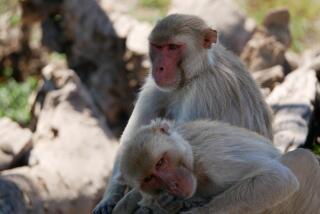SCIENCE / MEDICINE : Fossils of Primates Offer Clues to Primeval Courtship : Sexual roles: Larger canines, or fang teeth, suggest fierce competition among males for mates.
- Share via
“The earliest evidence of courtship behavior in primates” has been deduced from 50-million-year-old primate fossils discovered in central Wyoming.
The new fossils indicate that the males of the early species had much larger canines or “fang teeth” than females of the same species, suggesting that there was fierce competition among males for mates.
This difference in physical characteristics between males and females is known as sexual dimorphism, and the new discovery represents the oldest known record of sexual dimorphism in primates, according to paleontologists Richard Stucky of the Denver Museum of Natural History and Leonard Krishtalka and K. C. Beard of the Carnegie Museum of Natural History in Pittsburgh.
“These new specimens provide rare insight into the behavior and anatomy of some of the earliest primates who were closely related to our earliest tree-dwelling ancestors,” Stucky said.
The discoveries, reported last week in the Proceedings of the National Academy of Sciences, include four partial skulls and the most complete snout ever found of a rare primate known as Notharctus venticolus.
The specimens were recovered by Stucky and Krishtalka in 1989 at a site in the Wind River Basin of Wyoming, about 40 miles west of Casper. The site was discovered by them in 1984 and remains one of the richest sources of fossils from the Eocene Epoch 50 million years ago. They reported earlier this year that the site contains more than 100 species of mammals, reptiles, fish, birds and amphibians.
Specimens of Notharctus have been known to scientists since the late 1800s, but the latest specimens are more complete than any found in the past.
Notharctus closely resembled lemurs, small tree-dwelling primates that today exist only on the island of Madagascar off the east coast of Africa. They were approximately the size of a cat and lived in trees, feeding on leaves, seeds, fruit and insects.
Primates such as Notharctus flourished in North America 50 million years ago alongside the earliest horses and the ancestors of rodents, shrews and carnivores. They inhabited tropical forest environments that once extended across Wyoming and much of western North America.
The most significant finding in the new Notharctus fossils was that the male canines were more than twice as large as the females.
“Such a degree of difference in canine size between males and females is often linked in living monkeys to a distinct social structure in which males compete aggressively for females,” Krishtalka said. “When successful, these males often keep large harems,” he added.
The new discoveries will help researchers theorize about the behavioral development of early primates and modern humans. One of the hallmarks of human evolution, according to the fossil record, is the reduction about 12 to 14 million years ago in the size of male canines and the consequent equality in canine size between males and females, Stucky said.
These changes imply that monogamous male-female relationships eventually replaced the early forms of courtship behavior in the lineage of primates leading to modern humans.






